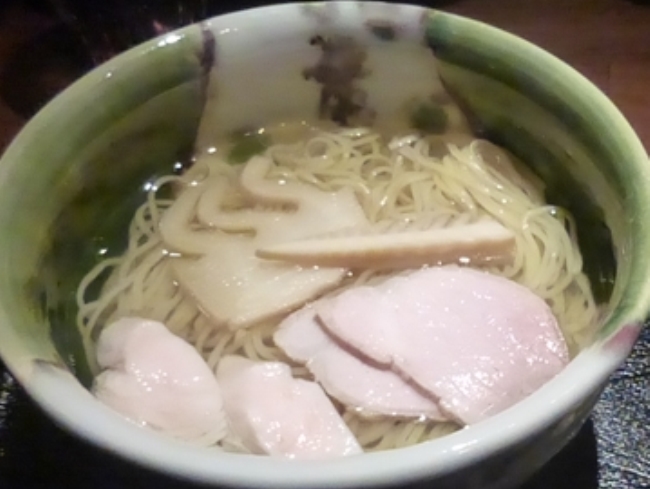
There’s no denying that we love our ramen here in Japan. The dish is so well-loved, in fact, that it can be called one of the national comfort foods of Japan, and one of the factors that make ramen so intriguing is the fact that there are so many variations of it across Japan, from the miso-based ramen of Hokkaido in the north to the pork-stock based tonkotsu ramen of Kyushu in the south.
Surrounded as we are by all the different ramens served at countless shops throughout the country, it’s rare that we see a ramen that surprises us with its originality, but when we heard about a ramen with a soup containing stock made from green tea — and expensive gyokuro tea at that — we have to say we were positively fascinated, and we knew we had to try it ourselves. Green tea ramen, here we come!
The gyokuro ramen we heard about was being served at the popular Menya Musashi shop in Shinjuku.
▼As we entered the shop, we were greeted by a red noren curtain featuring an image of Musashi Miyamoto, the legendary samurai after which the ramen chain was named.
▼Here’s what the counter looked like.
▼A close-up of the items laid out on the counter, including the chopsticks, spoons, toothpicks and condiments for the ramen:
▼You can see the ramen being cooked from across the counter.
There were several types of ramen on the menu, but of course, we were going to have the gyokuro ramen. Gyokuro green tea, by the way, is a special type of green tea that is grown in the shade instead of in the sun and is considered to be much more flavorful (and expensive) than the more widely consumed regular sencha green tea.
▼And here’s the green tea ramen we’d been waiting to taste! It came in a oribe-ware bowl, a detail designed to emulate the look and feel of a traditional Japanese tea cup.
▼The ramen looked like it wasn’t too heavy or oily, with a clear soup and no thick fatty slices of pork like you sometimes see. And while ramen is usually served piping hot, this gyokuro ramen was intentionally served at a lukewarm temperature of 55ºC (131ºF).
Apparently, the green tea stock for the ramen soup is extracted slowly and carefully by placing ice made from soft water from Shizuoka Prefecture on top of the gyokuro tea leaves. An original salt-flavored sauce made from sea bream stock is also added later to the soup.
▼Let’s take a look at the ingredients: there were pieces of bamboo shoots, delicately flavored and adding a slightly crunchy texture to the dish.
▼There were also thin slices of pork …
▼… and pieces of chicken, both of which were very mildly flavored.
▼The noodles were slightly on the thin side, but maybe not as thin as those used at some of the tonkotsu ramen shops.
▼The ramen also came with a serving of the gyokuro tea leaves flavored with a bit of soy-sauce and vinegar ponzu sauce. The refreshing tea was an interesting and delightful way to cleanse the palate.
▼By the time we left a little after 7 p.m. on a weekday evening the shop was full, with a line of about 6-7 people waiting for seats.
So, how did the green tea ramen taste? The gentle taste of the bamboo shoots, pork and chicken was quite enjoyable, and while the flavor of green tea did not seem exceedingly strong and obvious in the soup, it was overall a pleasant tasting bowl of ramen. It is a very light ramen, though, with very little fat, so if you want a something with a strong flavor, oily soup and plenty of fatty ingredients (which we believe many people may be looking for when having ramen), then you may want to go for a more standard type. On the other hand, if you’re not in the mood for anything too heavy, then this ramen with the slight aftertaste of refreshing green tea may work very well for you. One thing we did feel ambivalent about was the temperature of the soup, which they deliberately lowered to 55ºC. We’re not sure if this was done to preserve the delicate flavor of the green tea, but we felt we would have enjoyed the ramen even more if it was served hot. Still, we have to say we were quite impressed with the idea itself of using expensive tea to make ramen soup!
If you’re interested in trying the gyokuro ramen and don’t mind having your noodles lukewarm, they’ll be on the menu until November 30, but do take note that while Menya Musashi is a chain, the green tea ramen is available only at their Shinjuku shop, and they only serve 10 bowls each evening starting from 6 p.m. — and they do sell out, so make sure you don’t get there too late!
Shop Details
Menya Musashi Shinjuku Shop
Address: 7-2-6 Nishishinjuku, K1 Bldg. 1F, Shinjuku, Tokyo
(4 mins from JR Shinjuku Station West Exit)
Business Hours: Open every day 11:00~22:30
Tel: +81 3-3363-4634
All photos © RocketNews24














 Pizza Hut creates Putting our Soul into Every Bite Ramen Pizza with famous Japanese ramen chain
Pizza Hut creates Putting our Soul into Every Bite Ramen Pizza with famous Japanese ramen chain Drink Green! We check out the amazing “Green Tea Party” presented by Isetan and Ito En! 【Pics】
Drink Green! We check out the amazing “Green Tea Party” presented by Isetan and Ito En! 【Pics】 This London ramen restaurant’s super-strange ramen shocks our Japanese taste-tester
This London ramen restaurant’s super-strange ramen shocks our Japanese taste-tester Tokyo’s new chocolate ramen smothers us with attentive affection for Valentine’s Day【Taste test】
Tokyo’s new chocolate ramen smothers us with attentive affection for Valentine’s Day【Taste test】 Menya Musashi’s shaved ice ramen is the perfect dish to beat the Tokyo summer heat【Taste Test】
Menya Musashi’s shaved ice ramen is the perfect dish to beat the Tokyo summer heat【Taste Test】 Tokyo’s Super Mario Christmas decoration displays are super cool【Photos】
Tokyo’s Super Mario Christmas decoration displays are super cool【Photos】 This downtown Tokyo cafe is like a time machine that takes you back 50 years into the past
This downtown Tokyo cafe is like a time machine that takes you back 50 years into the past Station of despair: What to do if you get stuck at the end of Tokyo’s Chuo Rapid Line
Station of despair: What to do if you get stuck at the end of Tokyo’s Chuo Rapid Line Sailor Moon and J-pop mega-star Ayumi Hamasaki team up for collaboration, pre-defeat scalpers
Sailor Moon and J-pop mega-star Ayumi Hamasaki team up for collaboration, pre-defeat scalpers Japanese train station vending machine has the best souvenirs for rail otaku
Japanese train station vending machine has the best souvenirs for rail otaku Police called out to investigate suspicious Santa in Wakayama
Police called out to investigate suspicious Santa in Wakayama Japanese government will check and judge new baby name pronunciations, presents guidelines
Japanese government will check and judge new baby name pronunciations, presents guidelines Nintendo launches awesome, free Super Mario Wallpaper Maker website for PCs and smartphones
Nintendo launches awesome, free Super Mario Wallpaper Maker website for PCs and smartphones The results are in! One Piece World Top 100 characters chosen in global poll
The results are in! One Piece World Top 100 characters chosen in global poll Disney young adult novels get new beautiful shojo anime-style covers for Japan
Disney young adult novels get new beautiful shojo anime-style covers for Japan Japanese company develops classy heavy metal band frames for glasses
Japanese company develops classy heavy metal band frames for glasses Studio Ghibli showcases traditional craftsmanship with new wallet range
Studio Ghibli showcases traditional craftsmanship with new wallet range Major Japanese city is abolishing extracurricular activities at all of its middle schools
Major Japanese city is abolishing extracurricular activities at all of its middle schools One of Japan’s rarest sweets is a sell-out hit that looks and tastes like frost
One of Japan’s rarest sweets is a sell-out hit that looks and tastes like frost Mysterious light-up rainy night-sound Totoro figure doesn’t actually show a scene from the anime
Mysterious light-up rainy night-sound Totoro figure doesn’t actually show a scene from the anime Shakey’s is back! All-you-can-eat pizza chain returns to downtown Tokyo’s Shinjuku
Shakey’s is back! All-you-can-eat pizza chain returns to downtown Tokyo’s Shinjuku Starbucks Japan releases a new Frappuccino that looks and tastes like a floral bouquet
Starbucks Japan releases a new Frappuccino that looks and tastes like a floral bouquet Possessing Harry Potter’s Sword of Godric Gryffindor is now illegal in Japan
Possessing Harry Potter’s Sword of Godric Gryffindor is now illegal in Japan Uniqlo announces first-ever collaboration with horror manga master Junji Ito【Photos】
Uniqlo announces first-ever collaboration with horror manga master Junji Ito【Photos】 J-pop mega star Ado reveals she’s been living in the U.S., may not understand language acquisition
J-pop mega star Ado reveals she’s been living in the U.S., may not understand language acquisition Starbucks Japan is calling it quits with paper straws
Starbucks Japan is calling it quits with paper straws Japan’s most popular castle raising ticket prices by up to 200 percent for non-local tourists
Japan’s most popular castle raising ticket prices by up to 200 percent for non-local tourists Furikake rice seasoning sales are soaring, which is bad news for Japan as a whole
Furikake rice seasoning sales are soaring, which is bad news for Japan as a whole Studio Ghibli releases new range of cardigans for anime fans
Studio Ghibli releases new range of cardigans for anime fans Studio Ghibli heroine cardigans give you warmth and strength to face everyday challenges
Studio Ghibli heroine cardigans give you warmth and strength to face everyday challenges Eight unforgettable hot springs, as recommended by Japan’s “Professor Bath”
Eight unforgettable hot springs, as recommended by Japan’s “Professor Bath” McDonald’s new Happy Meals offer up cute and practical Sanrio lifestyle goods
McDonald’s new Happy Meals offer up cute and practical Sanrio lifestyle goods Foreign tourists on Shinkansen bullet train break suitcase etiquette, angering local passengers
Foreign tourists on Shinkansen bullet train break suitcase etiquette, angering local passengers [Deleted] Article written for April Fool’s Day 2018
[Deleted] Article written for April Fool’s Day 2018 Japanese government to make first change to romanization spelling rules since the 1950s
Japanese government to make first change to romanization spelling rules since the 1950s Foreigner’s request for help in Tokyo makes us sad for the state of society
Foreigner’s request for help in Tokyo makes us sad for the state of society Japanese convenience store Family Mart announces abolishment of eat-in spaces
Japanese convenience store Family Mart announces abolishment of eat-in spaces Life-size vibrating Legend of Zelda Master Sword for sale from Nintendo【Photos】
Life-size vibrating Legend of Zelda Master Sword for sale from Nintendo【Photos】 Princesses, fruits, and blacksmiths: Study reveals the 30 most unusual family names in Japan
Princesses, fruits, and blacksmiths: Study reveals the 30 most unusual family names in Japan Studio Ghibli releases free-download board game — Here’s how to play it without reading Japanese
Studio Ghibli releases free-download board game — Here’s how to play it without reading Japanese Bear ramen appears in Tokyo, causes almost as much shock as bears walking around the city would
Bear ramen appears in Tokyo, causes almost as much shock as bears walking around the city would We found a popular Japanese ramen chain in South Korea!…or so we thought
We found a popular Japanese ramen chain in South Korea!…or so we thought Is this $900 box of Japanese chocolates the perfect indulgence for sweets lovers?
Is this $900 box of Japanese chocolates the perfect indulgence for sweets lovers? This non-sweet matcha treat is one of our new favorite Kyoto snack souvenirs【Taste test】
This non-sweet matcha treat is one of our new favorite Kyoto snack souvenirs【Taste test】 Clash of the instant ramen! Taste-testing seven instant noodles on a flavor trip across Kyushu
Clash of the instant ramen! Taste-testing seven instant noodles on a flavor trip across Kyushu We Put A Bowl of Tonkotsu Ramen into a Rice Ball: Japan’s new demonic combini temptation
We Put A Bowl of Tonkotsu Ramen into a Rice Ball: Japan’s new demonic combini temptation A visit to the real-life Naruto Ramen Ichiraku anime restaurant that’s not in Japan【Photos】
A visit to the real-life Naruto Ramen Ichiraku anime restaurant that’s not in Japan【Photos】 We try out Pizza Hut Taiwan’s Ramen Pizza, try to figure out its national identity
We try out Pizza Hut Taiwan’s Ramen Pizza, try to figure out its national identity Michelin-listed ramen restaurant will turn you into a tiger with a single bite
Michelin-listed ramen restaurant will turn you into a tiger with a single bite Fried mochi ice cream ramen appears in Japan to simultaneously hit three comfort food bullseyes
Fried mochi ice cream ramen appears in Japan to simultaneously hit three comfort food bullseyes Have you tried Tokushima ramen? No? You should (says our obsessed Japanese-language reporter)
Have you tried Tokushima ramen? No? You should (says our obsessed Japanese-language reporter) Poisonous blowfish ramen restaurant in Tokyo is death-defyingly delicious【Taste test】
Poisonous blowfish ramen restaurant in Tokyo is death-defyingly delicious【Taste test】 How to make tonkotsu ramen at home 【SoraKitchen】
How to make tonkotsu ramen at home 【SoraKitchen】 Ramen shop in Nagoya offers monster servings of mouth-watering bamboo shoots as toppings
Ramen shop in Nagoya offers monster servings of mouth-watering bamboo shoots as toppings We try gold-topped ramen, the newest gourmet noodle treat in Tokyo and Kyoto【Photos】
We try gold-topped ramen, the newest gourmet noodle treat in Tokyo and Kyoto【Photos】 Chuka Zanmai instant ramen offering ultra luxurious limited-edition two-meal seat for $50
Chuka Zanmai instant ramen offering ultra luxurious limited-edition two-meal seat for $50
Leave a Reply